

Precursors of the Spedale Grande
In a bull of 1505, Pope Julius II approved the merger of four existing hospitals in Gubbio to form the “Spedale Grande”:
-
✴the Ospedale della Misericordia, whose premises formed the heart of the new institution;
-
✴the Ospedale Nuovo di Sant’ Agostino;
-
✴the Ospedali di Santa Maria della Carità; and
-
✴the Ospedale dei Calzolari.
Ospedale della Misericordia (1326)
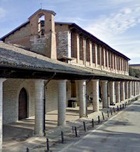
The hospital became part of t the “Spedale Grande” (see below) in 1505.
Maestà delle Logge (1473)
This fresco, which is attributed to Bernardino di Nanni dell’ Eugenia, is under what was the loggia of the Ospedale di Santa Maria dei Laici. It depicts Madonna and Child enthroned with SS Peter and Paul. The fictive architrave contains a series of coats of arms, and an angel in the lunette above holds an inscription that refers to indulgences granted by Pope Sixtus IV in 1473.
Hospitals of the Confraternita di Sant’ Agostino
The Confraternita dei Disciplinati del Crocifisso di Sant’ Agostino was documented in the 13th century, and is one of the oldest of the city’s lay confraternities.
Ospedale Vecchio (1349)
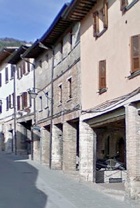
Ospedale di Umile (1289)
This hospice was established by a priest named Umile di Giacomo in a location documented as “iuxta Portam Pontis Marmorei” (next to a city gate named for a marble bridge across the Camignano). In 1410, by which time it was administered by the Commune, it was ceded to the Confraternita dei Disciplinati del Crocifisso di Sant’ Agostino whose existing hospital (the Ospedale Vecchio di Sant’ Agostino - above) was too small for its current purpose. It was not documented thereafter and was presumably closed when the confraternity completed its new hospital (below). This hospice was subsequently demolished and the site was used for the church of San Bernardino.
Ospedale Nuovo (1410)
The confraternity established the new hospice (which was also known as the Ospedale dei SS Vittore e Vittorino) further along Via Dante Alighieri, in houses that had belonged to the “signori della Branca”. This hospital was closed when its functions were absorbed by the Spedale Grande (below) in 1505. The bull setting up the new hospital confirmed the use of the site for the construction of the Monastero di SS Trinità. [Arms of the Confraternita dei Disciplinati del Crocifisso di Sant’ Agostino on the walls of the nunnery?]
Ospedale di Santa Maria della Carità (1295)
Three private citizens established this hospice, which was administered by the Commune. It was badly damaged during the attack on Gubbio by Braccio Fortebracci in 1420, and subsequently restored. Notwithstanding its absorption into the Spedale Grance in 1505, it continued in operation until at least 1521. Part of the complex to a new community of Capuchin nuns in 1561 and they adapted it to form the Monastero del Buon Gesù.
Ospedale dei Calzolari (1348)
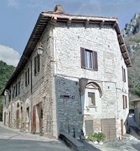
The guild itself was suppressed in 1801-2 and again in 1808-14. It sold these premises in 1981, when it moved to number 18, Via Savelli della Porta.
Pietà (1556)
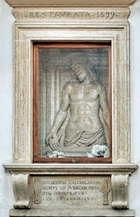
Societas Calceolariorum domus ad publicum pietatem
instauratur anno Domini MDLVI
The inscription on the upper part of its frame records its restoration in 1899.
Gonfalone dei Calzolari (1649-50)

The banner is painted in oil on canvas and has a silk surround. It depicts the Virgin holding the dead body of Christ, with St Crispin (the patron of the guild) and St Ubaldus to the sides and God the Father above.
Spedale Grande (1505)
As noted above, Pope Julius II approved the merger of four existing hospitals to form the “Spedale Grande” in 1505. Initially, the new institution was based in the existing premises of the Ospedale della Misericordia.
The Spedale Grande acquired the nearby church of Santa Croce del Mercato and its hospice, the “Ospitale degl’ Esposti” (hospice for foundlings), in 1598. It entered into a complex agreement with the Arte della Lana (wool weavers’ guild) in 1599, which provided that:
-
✴the hospital was create seven workshops on the ground floor of the hospital for the use of the merchants and build a covered loggia above (the Loggia dei Tiratori) in which they could dry out their wares; and
-
✴the wool merchants would finance the construction of a new hospital next to the church of Santa Croce del Mercato.
This agreement was subject to a series of disputes that delayed the projects”
-
✴the Loggia dei Tiratori was finally built in 1603; and
-
✴the infermeria Nuova was completed in 1628 (see below)
One the new infirmary was complete, the old Ospedale della Misericordia was reserved for the use of the wool merchants. The site is now used by a bank and café, and its portico houses a small market.
Infermeria Nuova (1628)
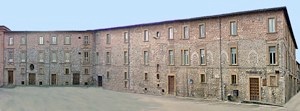
This new hospital was built next to the church of Santa Croce del Mercato, and subsumed the fabric of the Ospitale degl’ Esposti. This new structure extends from the “Speziaria” (old apothecary with its portal at the extreme left) to the present Farmacia Comunale at the extreme right. The remains of the old “Ruota degl’ Esposti” (opening for admitting abandoned babies) can be seen to the left of the second portal from the right.
Ospedale Grande Rinnovato (1746-66)
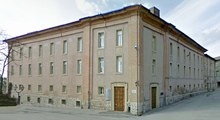
Discussion of the need for a new hospital in Gubbio began in 1709. However, it only became a possibility after a bequest from the Marchese Gioia della Rena. In 1746, the design was commissioned from Carlo Murena and Antonio Francesco Berardi di Cagli for a site next to the existing hospital, facing the facade of San Francesco. (The earlier hospital is at the extreme right in this photograph). The foundation stone was laid in 1749 and the project was completed in 1766.
The church of Santa Croce del Mercato was demolished in 1823 and the two adjacent hospitals formally merged in 1856. They remained in operation until 2008.
Read more:
P. Menichetti, “I 50 ospedali di Gubbio”, (1975) Città di Castello
The following hospices are described in other pages of this site: Ospedale di Spirito Santo;
Return to Monuments of Gubbio.
Return to Walk I (all hospitals described here except the two below).
Return to Walk II (Ospedale di Santa Maria della Carità; Ospedale dei Calzolari).

